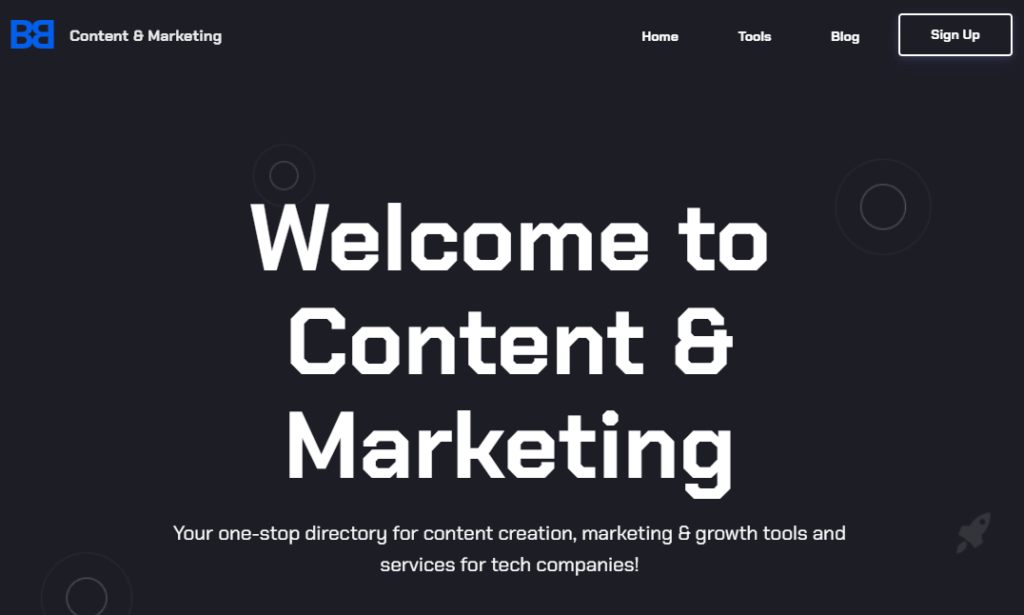Welcome to the world of content marketing! Here, we explore how to grab attention and keep it. Content marketing is all about creating exciting stories and helpful information that people want to share. Think of it as a treasure map that leads customers to your brand.
In this guide, we will look at the many ways content can increase your business. From social media posts to email marketing, we’ll show you how to connect with your audience. Prepare yourself to learn about SEO, lead generation, and more. Let’s open up the secrets to making your brand shine!
Key Takeaways
- Compelling content drives engagement, social shares, and brand interaction, necessary for business growth.
- Strategic use of content marketing, including blogs, social media, and email, enhances visibility and customer connection.
- Quality leads generated through effective content marketing have higher conversion rates and customer lifetime value.
- Content marketing is critical for B2B growth, attracting and converting prospects while building brand trust.
Understanding Content Marketing Fundamentals
As we explore into into the area of content marketing, we find a strategic approach that emphasizes creating and distributing valuable, relevant, and consistent content. This method is designed to attract and retain a clearly defined audience, in the end driving profitable customer action.
Understanding the content marketing cycle is critical. It allows us to use each phase effectively, enhancing our in general marketing strategy. Here’s a quick breakdown:
- Content Creation: Crafting engaging articles, videos, and social media posts.
- Content Distribution: Sharing our content across different platforms to reach our target audience.
- Audience Engagement: Interacting with our audience to build relationships and trust.
- Analytics: Measuring performance to refine our strategy and improve future content.
By utilizing techniques such as SEO and storytelling, we can improve brand awareness and guide our audience through the customer journey. This multifaceted approach not only boosts lead generation but also optimizes our conversion rates.
“Content is the present—and future—of marketing.”
Basically, mastering these fundamentals equips us to steer the dynamic place of digital marketing effectively.
Exploring Digital Marketing Strategies
Digital marketing is our modern playground, where brands connect with consumers through different online tactics. One of the most effective approaches is content marketing, which focuses on building trust and fostering lasting relationships. By providing valuable content, we can engage our audience and encourage them to take action.
Here are some key strategies we can employ:
- SEO: Optimizing our content for search engines ensures visibility and attracts organic traffic.
- Social Media Marketing: Leveraging platforms like Instagram and Twitter helps us reach our audience where they spend time.
- Email Marketing: Personalized emails can nurture leads and keep our brand top-of-mind.
- PPC Advertising: Targeted ads can drive immediate traffic and conversions.
Analytics play a critical role in refining our strategies. By tracking user engagement and conversion rates, we can adjust our approach to better meet customer needs. For a deeper look at crafting a successful content strategy, check out this ultimate guide.
In this dynamic place, staying adaptable is key. As we explore these strategies, let’s don’t forget the ultimate goal is to create meaningful connections with our audience.
The Role of SEO in Content Marketing
We all know that combining SEO with content marketing is like peanut butter and jelly—deliciously effective! By integrating search engine optimization into our content strategy, we create valuable resources that not only engage our audience but also attract search engines.
Initial off, keyword research is necessary. It helps us identify what our audience is searching for, allowing us to tailor our content accordingly. When we use the right keywords, we increase our chances of ranking higher in search results, driving more organic traffic to our site.
Next, let’s talk about backlinks. These are like votes of confidence from other websites. When we produce high-quality content, others are more likely to link back to us, which enhances our search engine ranking.
At last, we can’t forget about analytics. By monitoring user engagement and conversion rates, we can refine our strategies to make sure our content resonates with our audience. This cycle of creation, promotion, and optimization is what keeps our digital marketing efforts thriving!
| SEO Component | Role in Content Marketing |
|---|---|
| Keyword Research | Guides content creation to match audience queries |
| Backlinks | Boosts authority and search rankings |
| Analytics | Informs strategy adjustments for better engagement |
Leveraging Social Media Marketing for Engagement
We can harness the power of social media marketing to ignite audience engagement like never before. By strategically utilizing platforms such as Instagram, Twitter, and Facebook, we can create dynamic social media campaigns that connect with our target audience.
Engagement is not just about likes; it’s about fostering genuine customer interaction. Here’s how we can lift our game:
- Visual Content: Eye-catching images and videos can capture attention and drive shares.
- User-Generated Content: Encouraging fans to create content fosters community and authenticity.
- Influencer Marketing: Collaborating with influencers can amplify our reach and credibility.
Also, employing marketing analytics allows us to track engagement metrics effectively. This data-driven approach helps us refine our social media strategy and improve our online presence.
By accepting these techniques, we not only increase brand awareness but also cultivate a loyal community around our brand. Let’s get creative and make our mark in the digital place!
Developing an Effective Content Strategy
Creating a content strategy is necessary for any successful marketing initiative. We must initial determine our goals: Are we aiming to increase brand awareness, generate leads, or drive sales?
Each objective shapes our approach.
Next, we look at audience analysis. Understanding our target audience allows us to tailor content that resonates with them. This involves researching their preferences and pain points, ensuring our brand messaging aligns with their needs.
Once we know our audience, we can develop a content calendar. This tool helps us organize different content types—like blog posts, videos, and infographics—while maintaining a consistent posting schedule. Regularity is key to testing our audience engaged.
Also, we should incorporate SEO optimization into our strategy. By using relevant keywords and optimizing our content for search engines, we improve visibility and attract organic traffic.
At last, we must analyze engagement metrics and conversion rates to assess our strategy’s effectiveness. This data informs adjustments to improve our content and better serve our audience.
Implementing Inbound Marketing Techniques
Inbound marketing is our secret weapon for attracting and engaging potential customers. By creating valuable and relevant content, we can connect with our audience’s needs and interests. This organic approach combines SEO, content marketing, and a customer-centric focus to create a seamless experience.
Here’s how we can do effective inbound marketing techniques:
- Define Buyer Personas: Understanding who our audience is helps tailor our content.
- Create a Blog Strategy: Regularly posting informative articles boosts SEO and drives traffic.
- Use Social Media Marketing: Engaging with our audience on platforms they frequent enhances visibility.
- Do Email Marketing: Personalized emails nurture leads and keep our brand top-of-mind.
- Optimize Landing Pages: Clear calls to action and engaging content convert visitors into leads.
“Content is the present—and future—of marketing.”
By focusing on the customer journey, we can effectively guide prospects through the marketing funnel, ensuring they receive the right content at the right time. With analytics, we can refine our strategies and improve audience engagement continuously.
Utilizing Email Marketing for Customer Retention
Email marketing is our secret weapon for boosting customer retention. By crafting engaging email campaigns, we can nurture organic relationships with our audience. Imagine sending tailored content that resonates with our customers, making them feel valued and understood.
Here’s how we can boost our strategy:
- Segmentation: Divide our audience based on preferences and behaviors to deliver relevant content.
- Personalization: Use customer names and past purchase data to create a more intimate experience.
- Automation: Set up automated messages for birthdays or special occasions to keep our brand top-of-mind.
Plus, we should track key metrics like open rates and click-through rates to refine our approach. A/B testing different subject lines can reveal what truly captivates our audience.
In the end, effective email marketing not only drives sales but also cultivates loyalty. By continuously gathering customer feedback and analyzing analytics, we can adapt our strategies to meet changing needs, ensuring our customers remain engaged throughout their customer lifecycle.
Enhancing Audience Engagement through Brand Storytelling
We all know that effective content acts as a bridge between our brand and our audience. By utilizing brand storytelling, we can nurture deeper audience engagement and loyalty. When we share narratives that connect with our audience’s values, we create a shared identity that draws them closer.
Here’s how we can improve engagement through storytelling:
- Emotional Connection: Stories evoke emotions, making our brand relatable and memorable.
- Visual Storytelling: Incorporating images and videos can amplify our message, capturing attention effectively.
- Interactive Content: Engaging our audience through polls or quizzes can make them feel involved.
Also, a well-crafted narrative strategy can differentiate our brand in a crowded market. By focusing on customer experience and employing storytelling techniques, we can improve our brand identity and increase brand loyalty.
“Stories help brands connect with consumers on a personal level.”
In the area of digital marketing, leveraging these storytelling frameworks can remarkably improve our content creation efforts, in the end driving sales and fostering a loyal customer base.
The Importance of Content Creation in Marketing
Content creation is the heartbeat of modern marketing, driving audience engagement and establishing brand awareness. By crafting valuable and relevant content, we can attract and retain customers, ensuring they see our brand as a trusted resource.
Consider the following key aspects of effective content creation:
- Storytelling: Engaging narratives connect with audiences, making our content memorable and shareable.
- SEO: Optimizing content for search engines enhances visibility, driving organic traffic to our platforms.
- Marketing Channels: Utilizing diverse channels like social media, email, and blogging ensures our content reaches a wider audience.
Also, a well-defined marketing strategy integrates content across all platforms, reinforcing our message and enhancing lead generation. As we analyze consumer behavior, we can tailor our content to meet their needs, fostering loyalty and trust.
In the end, the effectiveness of our content marketing hinges on its ability to inform, entertain, and inspire action, making it an indispensable tool in our marketing arsenal.
Analyzing Marketing Performance with Analytics Tools
We look at the exhilarating world of marketing performance through the lens of analytics tools. These tools are our guiding light, illuminating the path to understanding how our campaigns connect with audiences. By employing data analysis, we can uncover critical marketing metrics that reveal the effectiveness of our strategies.
For instance, utilizing A/B testing allows us to compare different versions of our content, helping us pinpoint what truly engages our audience. This leads to enhanced conversion rates and in the end, improved ROI analysis. Also, web analytics provides insights into user behavior, enabling us to refine our marketing strategies based on real-time data.
Let’s not forget the power of data visualization. It transforms complex data sets into digestible insights, making it easier for us to track key performance indicators and optimize our campaigns. By segmenting our audience, we can tailor our messages, ensuring they connect deeply with each group.
Basically, leveraging these analytics tools is not just about measuring success; it’s about understanding our customers and enhancing their experience with our brand.
Summing up
Understanding content marketing is like having a treasure map. We learn how to use tools to find our audience and increase our brand. With the right strategies and analytics, we can see what works and what doesn’t. This helps us make smart choices and drive better results. So, let’s grab our tools and start measuring our success! The journey to mastering content marketing is just beginning, and we are ready to shine!

